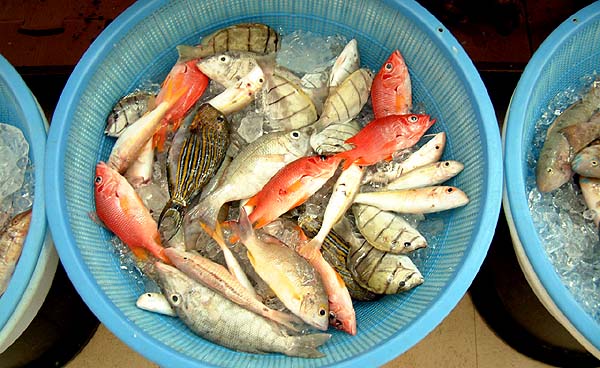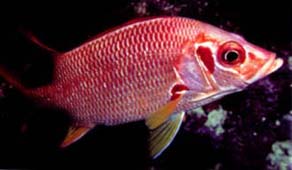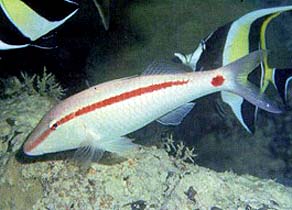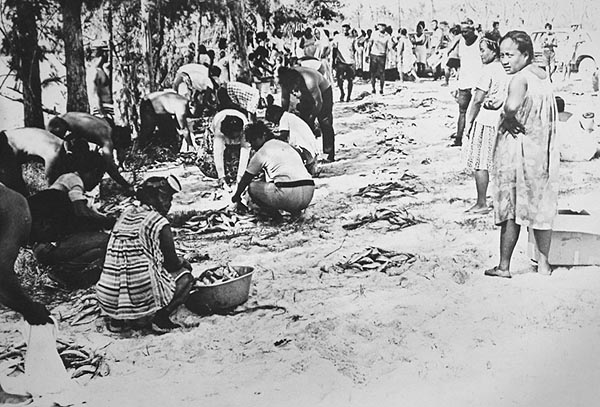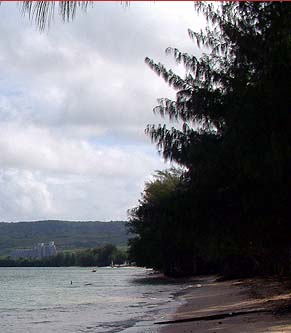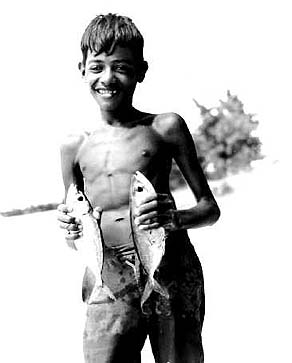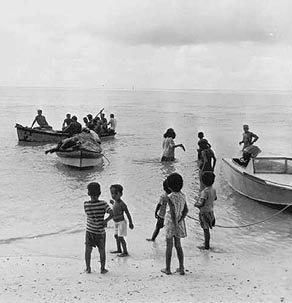 |
 |
 |
|||||
|
|
|
|
|
|
|
|
|
|
|
|||||||
|
|
|
|
|
|
“Pes are taboos," Ben explains. "If you received some kind of Carolinian medicine because you were sick, they will give you a taboo not to eat this kind of fish, and so those people don’t catch those fish. They don’t even put it together with their other catch. It is that kind of taboo. That I remember very vividly."
|
||
|
|
||
“One time a boat was turned upside down— they do that so the sun will kill the algae—and being young, and probably dumb, I climbed up and I slipped, and I dove head first into the sand. And there were pieces of coral there, so I got all this coral stuck in my face. I had to be taken to a Carolinian medicine woman, and then she massaged it, took out the corals, and said a few words in Carolinian for the good Spirit to help heal this injury. "When that was done, my parents made food, and shared it with the medicine woman, and they talked and they made certain that I don’t eat this red fish. In Carolinian we call it harrah and in Chamorro we call it sisi’ok, and in English it’s the squirrel fish, the one with the barbs sticking out on this side. I was asked not to eat that one. "I try not to eat it, but I heard people say they are the most delicious fish! You’re never suppose to eat it. Ever again. It is taboo. And I still try not to today. Every time I see it, I say, 'Oh, you better take it!' "
|
|
|
“The old-timers, they had their own way,” Dave explains. “And there’s a saying that you can speak to the spirit of the deceased. That’s what I learned from when I was young. So I still respect as part of my culture. “My mom was a suruhana. She could heal people just by praying. Some sick people are being attacked by ghosts or spirits. My mom used to heal them. They’d come to our house. I remember seeing a person being taken into our house, and she was very weird like she was trying to fight back. "But when my mother applied the power of the suruhana, the spirit or ghost eventually separated from that person."
|
|
|
|
“My mom was Carolinian, and she did it through praying what she had been taught. She received some sort of power from the old people. She also used medicinal plants and herbs. I am qualified to tell you about them, but we have our own power of medicine that is given by our mom, and we cannot just take it out and show it to people. We will use it on ourselves at a time that we need it, in the family."
|
||
|
|
||
“A long time ago the old Carolinians, especially if they were suruhana, needed to distinguish the fish that they could eat. Because if you eat the taboo fish, the ghost will come back and attack you. That is what we call pes. Those people who are not involved in the pes, they can eat the fish. But those people who have the power of the suruhana, curing and healing people with their magic spirit, they cannot eat those fish. “The traditional healer that’s giving you the medicine would designate what kind of fish not to eat,” Pete says. “So you better not eat that kind of fish. Once he says that you’re not supposed to eat it, or if the entire family’s not supposed to eat it, then whenever you go fishing, you’d best select what kind of fish you’re going to bring home. You cannot bring home the pes fish. You cannot mix it with your other catch."
|
|
|
“The type of fish depends on the medicine person who was mixing the medicine. It’s not the medicine they gave you. It’s the person giving you the medicine. They designate what kind of fish you cannot eat.” “Mostly, that’s squirrel fish (harrah),” Ben says, “certain groupers which we call gulufei in Carolinian, and a certain goatfish called fenisi. Those are the three most common taboo or pes that were give by the medicine person.” “That’s an interesting part of our culture that we had to learn,” Dave reflects, “distinguishing what to eat. A long time ago, there were a lot of pes fish. And those were the best fish."
|
|
|
|
|
“So let’s say that you catch the fish and you like to eat the fish and you’re not a suruhana, you can just go ahead and barbeque the fish on the beach and eat it, but do not bring it home. If you catch a fish that is distinguished to be a pes, you cannot eat this in the house. You cannot barbeque the fish in the place where the family’s eating. You have to take it away from that area. You have to stay and barbeque on the beach. Because if you bring it home, they are going to chase you out from the house. “If you’re practicing as a suruhana, you cannot eat it for the rest of your life. Especially turtle. If you’re a suruhana, you cannot eat turtle. You cannot eat fish like the red fish, red snapper. And if the suruhana distinguishes that you cannot eat a certain fish, you cannot eat that fish. Because what happens when you eat the fish? That ghost will turn around and attack you again.”
|
||
|
|
||
“The suruhana will tell you that if you go fishing, nighttime or daytime, spear fishing or net fishing, the first fish that you catch you have to mark,” Dan says. “You have to bite the tail to mark your first catch. Then when you finish fishing and you reach the sand, then you have to take that fish and hang it in a tree, and that’s for the spirit of the water. Either big or small catch, doesn’t matter. That’s for the spirit of the water. “If you walked on the beach before, in Tanapag, you could smell fish. All the fisherman were hanging the first catch in the trees. I’m still doing it. First catch.”
|
|
|
“That’s called ahome,” Pete says. “Whenever we’d go fishing, we go to Managaha for lunch, and then we would select a good fish, and hang it on the tree for the spirits.” “For the ocean spirits, and for the fishermen’s spirits that guide them and make them catch fish,” Ben adds. “Not only on the shorelines,” Pete continues, “but sometimes at the side of your house. The old people, the old women, they’d select one of the good fish and just hang it somewhere beside the house. I really don’t know why, but I don’t do it anymore.” “What about this sign?” Ben says, drawing a dollar sign. “I think that has changed our culture, our tradition tremendously.”
|
“In our younger days, our Carolinian ancestors would make sure that we don’t bring banana for lunch on the boat.” Ben recalls. “I heard and learned from the older Carolinians about this. They said, ‘Do not bring banana as lunch because it will give you bad luck.’ If you’re going out in ocean, don’t bring fish for lunch, because it will make you not catch fish. It gives you bad luck.” “You cannot sleep with your wife before fishing,” Pete adds. “Or you will have bad luck. I believe that.” “And before you go fishing, you don’t go to the cemetery,” Ben says. “When somebody dies in the village,” Pete elaborates, “they don’t allow you to go fishing. During those times, when a person died they would just have a wake. Then the following day they would be buried. As soon as they bury the dead person, you can go fishing.”
|
|
|
|
|
Observing the regulations about eating pes fish is strongly linked to traditions concerning respect in Tanapag's Carolinian culture.
|
||
|
|
||
|
|
|
|
|
|

|
| Tanapag Home | Map Library | Site Map | Pacific Worlds Home |
|
|
|
|

|
|
|
|||
| Copyright 2003 Pacific Worlds & Associates • Usage Policy • Webmaster |
|||
